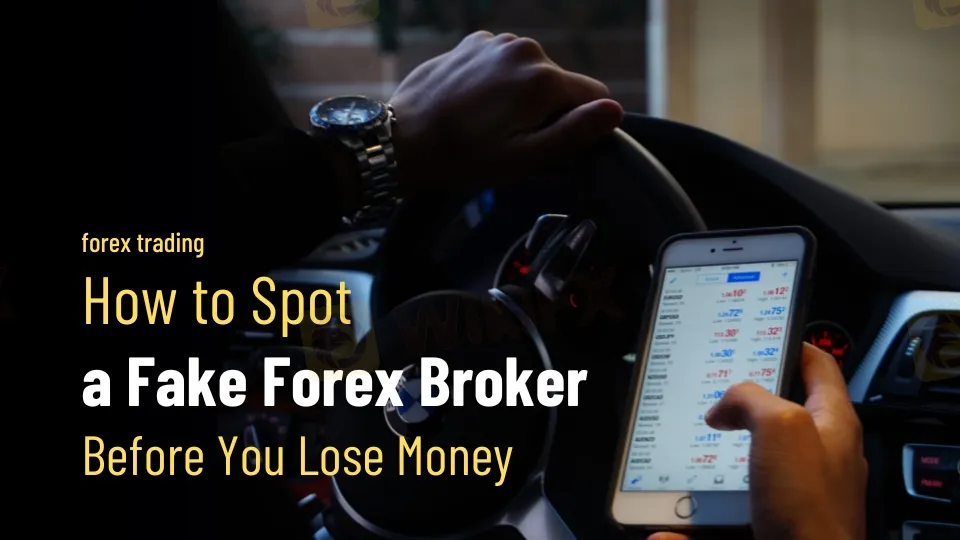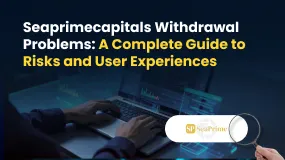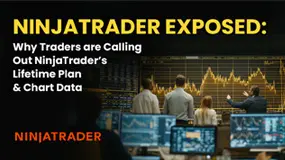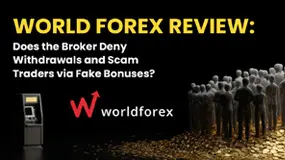简体中文
繁體中文
English
Pусский
日本語
ภาษาไทย
Tiếng Việt
Bahasa Indonesia
Español
हिन्दी
Filippiiniläinen
Français
Deutsch
Português
Türkçe
한국어
العربية
How to Spot a Fake Forex Broker Before You Lose Money
Abstract:Know how to spot fake Forex brokers and protect your investments. Verify regulatory status, watch out for unrealistic claims, and use tools like WikiFX for added security.

The foreign exchange (forex) market is one of the most dynamic and liquid financial markets globally, with a staggering daily trading volume of over $6 trillion. But with such vast opportunities come significant risks, particularly from fraudulent actors. Fake forex brokers are a growing concern, preying on both new and seasoned traders and often leaving them with heavy financial losses. To safeguard your investments, it‘s essential to know how to spot and steer clear of these scams. In this article, we’ll walk you through practical steps to identify fake brokers, with a special focus on how tools like WikiFX can help you stay informed and protected.
Start by Checking the Brokers Regulatory Status
One of the most reliable ways to spot a fake forex broker is by verifying their regulatory credentials. Legitimate brokers are required to be licensed and regulated by reputable financial authorities in their operating regions. These regulatory bodies enforce strict rules to ensure transparency, fair trading practices, and adequate capital reserves.
Why Regulation is a Big Deal
Regulated brokers are held to high standards and are accountable for their actions. If a broker isn‘t regulated, you’re essentially left without a safety net if things go wrong. Trusted regulators like the Financial Conduct Authority (FCA) in the UK, the Commodity Futures Trading Commission (CFTC) in the US, and the Australian Securities and Investments Commission (ASIC) are known for their rigorous oversight.
How to Verify a Brokers Regulatory Status
- Check Their Website: Legitimate brokers usually display their regulatory details prominently, including their license number and the name of the overseeing authority.
- Cross-Reference with Regulatory Databases: Platforms like WikiFX can help you verify a brokers claims by aggregating data from multiple regulatory bodies.
- Watch for Red Flags: If a broker‘s regulatory information is vague, inconsistent, or missing altogether, it’s a strong sign of potential fraud.
By ensuring your broker is properly regulated, you drastically lower the risk of falling victim to a scam.
Be Skeptical of Unrealistic Profit Promises
Fake brokers often lure traders with the promise of guaranteed profits or sky-high returns. While forex trading can be lucrative, its also inherently risky. Any broker claiming to eliminate these risks is almost certainly a fraud.
Legitimate brokers focus on educating traders and providing tools to manage risk, not making outlandish promises. Theyll emphasize the importance of understanding market volatility and making informed decisions.
How to Spot Unrealistic Claims
- Too Good to Be True: If a broker promises consistently high returns with minimal risk, its a major red flag.
- High-Pressure Tactics: Scammers often push you to deposit funds quickly, using urgency to cloud your judgment.
- Lack of Transparency: Reputable brokers are upfront about trading conditions, including spreads, fees, and leverage. If this information is hard to find or unclear, proceed with caution.
WikiFX offers user reviews and expert analyses, making it easier to identify brokers making unrealistic claims. This resource can help you steer clear of brokers that prioritize flashy marketing over genuine service.

Scrutinize Deposit and Withdrawal Processes
The way a broker handles deposits and withdrawals can reveal a lot about their legitimacy. Fake brokers often make it easy to deposit funds but nearly impossible to withdraw them.
Key Things to Look For
- Deposit Methods: Legitimate brokers offer a range of secure payment options, including bank transfers, credit cards, and e-wallets. Be cautious if a broker only accepts untraceable methods like cryptocurrency.
- Withdrawal Policies: Check the brokers withdrawal terms, including processing times and fees. Excessive delays or hidden charges are common tactics used by scammers.
- Account Verification: Reputable brokers require identity verification (KYC) to comply with anti-money laundering laws. If a broker skips this step, its a red flag.
WikiFX provides detailed insights into brokers deposit and withdrawal processes, including user-reported experiences. This information can help you avoid brokers with questionable practices before you commit your money.
Pay Attention to Online Reputation
In today‘s digital world, a broker’s online reputation can tell you a lot about their trustworthiness. Fake brokers often leave a trail of negative reviews and unresolved complaints.
How to Evaluate a Brokers Reputation
- Read Reviews: Check independent platforms like Trustpilot, Forex Peace Army, and WikiFX for user feedback. Look for recurring issues, such as withdrawal problems or poor customer service.
- Check Social Media: Legitimate brokers actively engage with clients on social media. A lack of presence or negative interactions can be a warning sign.
- Research Complaints: Search for the brokers name alongside terms like “scam” or “fraud” to uncover any unresolved issues.
WikiFX compiles user reviews and ratings, giving you a comprehensive picture of a brokers reputation. This can help you avoid brokers with a history of shady practices.
Ensure the Brokers Website is Secure
A secure website is a basic requirement for any legitimate broker. Fake brokers often skimp on security, putting your personal and financial information at risk.
What to Look For
- HTTPS Protocol: Make sure the brokers website uses HTTPS (look for the padlock icon in the address bar). This indicates the site is encrypted and secure.
- Privacy Policy: Legitimate brokers have a clear privacy policy explaining how they protect your data. If this is missing or vague, its a red flag.
- Two-Factor Authentication (2FA): Reputable brokers often offer additional security measures like 2FA to protect your account.
WikiFX evaluates brokers websites for security features, helping you identify those that meet industry standards. This extra layer of verification can give you confidence in your choice.
Final Thoughts
Identifying a fake forex broker requires a mix of due diligence and the right tools. By verifying regulatory status, avoiding unrealistic promises, scrutinizing deposit and withdrawal processes, assessing online reputation, and ensuring website security, you can significantly reduce your risk of falling victim to a scam. Platforms like WikiFX are invaluable in this process, offering the information and resources you need to make informed decisions.
In the fast-paced world of forex trading, staying informed and vigilant is your best defense against fraud. By following the steps outlined here, you can protect your investments and trade with confidence. Remember, if something sounds too good to be true, it probably is. Always prioritize safety and transparency when choosing a forex broker.

Disclaimer:
The views in this article only represent the author's personal views, and do not constitute investment advice on this platform. This platform does not guarantee the accuracy, completeness and timeliness of the information in the article, and will not be liable for any loss caused by the use of or reliance on the information in the article.
Read more

Seaprimecapitals Withdrawal Problems: A Complete Guide to Risks and User Experiences
Worries about Seaprimecapitals withdrawal problems and possible Seaprimecapitals withdrawal delay are important for any trader. Being able to get your money quickly and reliably is the foundation of trust between a trader and their broker. When questions come up about this basic process, it's important to look into what's causing them. This guide will tackle these concerns head-on, giving you a clear, fact-based look at Seaprimecapitals' withdrawal processes, user experiences, and trading conditions. Most importantly, we'll connect these real-world issues to the single most important factor behind them: whether the broker is properly regulated. Understanding this connection is key to figuring out the real risk to your capital and making a smart decision.

iFX Brokers Review: Do Traders Face Withdrawal Issues, Deposit Credit Failures & Free Coupon Mess?
Have you had to pay several fees at iFX Brokers? Had your trading profit been transferred to a scamming website, causing you losses? Failed to receive withdrawals from your iFX Brokers trading account? Has your deposit failed to reflect in your trading account? Got deceived in the name of a free coupon? Did the broker officials not help you in resolving your queries? Your problems resonate with many of your fellow traders at iFX Brokers. In this iFX Brokers review article, we have explained these problems and attached traders’ screenshots. Read on!

NinjaTrader Exposed: Why Traders are Calling Out NinjaTrader’s Lifetime Plan & Chart Data
Did NinjaTrader onboard you in the name of the Lifetime Plan, but its ordinary customer service left you in a poor trading state? Do you witness price chart-related discrepancies on the NinjaTrader app? Did you have to go through numerous identity and address proof checks for account approval? These problems occupy much of the NinjaTrader review online. In this article, we have discussed these through complaint screenshots. Take a look!

World Forex Review: Does the Broker Deny Withdrawals and Scam Traders via Fake Bonuses?
Does World Forex prove to be a not-so-happy trading experience for you? Do you struggle to withdraw your funds from the Saint Vincent and the Grenadines-based forex broker? Do you witness hassles depositing funds? Failing to leverage the World Forex no deposit bonus, as it turned out to be false? These accusations are grabbing everyone’s attention when reading the World Forex review online. In this article, we have shared some of these. Read on!
WikiFX Broker
Latest News
GGCC Bonus and Promotions: A Data-Driven Analysis for Experienced Traders
Close Up With WikiFX —— Take A Close Look At Amillex
CapEx Spending On AI Is Masking Economic Weakness
Questrade Review Pros, Cons and Regulation
AccentForex Review: Is It Safe to Invest or Scam?
Is Your Money Safe? The Capital.com Withdrawal Mystery Revealed
World Forex Review: Does the Broker Deny Withdrawals and Scam Traders via Fake Bonuses?
Revolut Expands in South Africa with Banking Licence Move
The Broker Dilemma: Why Your Choice Could Make or Break Your Forex Journey
【WikiEXPO Global Expert Interviews】Sheikh Muhammad Noman: The Future of Investment in the GCC
Currency Calculator



